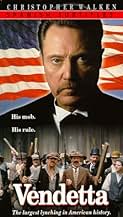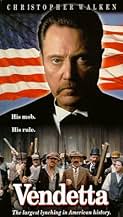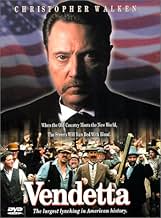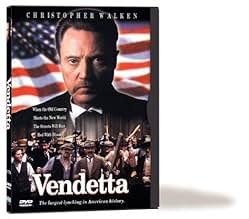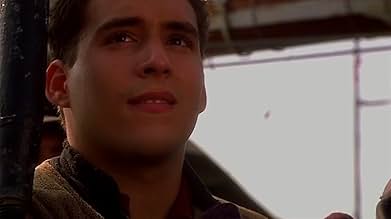IMDb-BEWERTUNG
6,1/10
1377
IHRE BEWERTUNG
Füge eine Handlung in deiner Sprache hinzuBased on a true tale of power, corruption and murder, Christopher Walken stars in the story of the largest lynching in American history...Based on a true tale of power, corruption and murder, Christopher Walken stars in the story of the largest lynching in American history...Based on a true tale of power, corruption and murder, Christopher Walken stars in the story of the largest lynching in American history...
- Regie
- Drehbuch
- Hauptbesetzung
George Martin
- Judge Baker
- (as George N. Martin)
Empfohlene Bewertungen
This film is based on a real story of a century ago that probably is not in any of the New Orleans tourist brochures. Thirty thousand Italians were brought into New Orleans between the end of the Civil War and 1890 as a source of cheap labor to work on the docks and in the farm produce market. There is real money to be made and some of the most powerful men in the city resent the wealth of two Italians who have given their countrymen an incentive to be very productive. The police chief who won't go along with a takeover plot hatched by the mayor and the men who have put the mayor in power is assassinated. A group of Italians who are in the wrong place at the wrong time and the two wealthy Italian businessmen are framed. After the courtroom drama, there is an even more dramatic finale.
African Americans were not the only group lynched in the US. In the 1890s, there were six lynchings of Italians, three of them in Louisiana. This is the story of one such lynching in New Orleans.
After the emancipation in 1865, the power in New Orleans imported Sicilians to replace the African American. After a time, they came to regret this decision, as the Italian population grew to about 30,000 by 1890. They, particularly James Huston (Christopher Walken), set about trying to play the two factions of Sicilians (the Machecas and the Provenzanos) against each other.
It should be noted that politically correct terminology is not used for the two races.
Since the Sheriff (Andrew Connolly) wouldn't go along with the Mayor (Kenneth Welsh) and the other leaders, he was disposed of. Another policeman (Luke Askew) reported that "dagos" did it and riots ensued. Six men were pointed out by a "witness" that was intimidated by the police.
A "trial" was held, but the results weren't what the town expected, so they took matters into their own hands, stirred up by the Mayor with threats by Huston that it will be done "with you or without you." Of course, many more were murdered in the real event that took place, but this is a movie.
Huston got what he wanted.
After the emancipation in 1865, the power in New Orleans imported Sicilians to replace the African American. After a time, they came to regret this decision, as the Italian population grew to about 30,000 by 1890. They, particularly James Huston (Christopher Walken), set about trying to play the two factions of Sicilians (the Machecas and the Provenzanos) against each other.
It should be noted that politically correct terminology is not used for the two races.
Since the Sheriff (Andrew Connolly) wouldn't go along with the Mayor (Kenneth Welsh) and the other leaders, he was disposed of. Another policeman (Luke Askew) reported that "dagos" did it and riots ensued. Six men were pointed out by a "witness" that was intimidated by the police.
A "trial" was held, but the results weren't what the town expected, so they took matters into their own hands, stirred up by the Mayor with threats by Huston that it will be done "with you or without you." Of course, many more were murdered in the real event that took place, but this is a movie.
Huston got what he wanted.
This was a fairly interesting historical drama, but the portrayals were so black and white that the story seemed improbable to me. I suspect the true story is a bit more "gray" than the movie suggests. Our politically correct society allows these one sided views only when the "white anglo saxon protestant" male is the villain.
Theodore Roosevelt was contemptuous of races and nations he considered inferior. When a mob in New Orleans lynched a number of Italian immigrants, Roosevelt thought the United States should offer the Italian government some remuneration, but privately he wrote his sister that he thought the lynching was "rather a good thing" and told her he had said as much at a dinner with "various dago diplomats . . . all wrought up by the lynching."
This was the attitude of America in 1891. The New York Times on March 14, 1891, published an article describing the events in this film with the following headline: CHIEF HENNESSY AVENGED; ELEVEN OF HIS Italian ASSASSINS LYNCHED BY A MOB. The attitude of the whites in New Orleans can best be summed up by the comments from one businessman, "I would rather have a thousand Chinamen, than one Italian.
This information is critical to understanding the movie, the truth of which is well documented. It was not just African Americans that suffered lynching after the Civil War, many Italians suffered the same fate across the country, but mostly in the South.
Timothy Prager's script hewed very closely to Richard Gambino's book. The performances were outstanding, particularly Christopher Walken, Joaquim de Almeida, and Clancy Brown, in the short time he was on screen. Alessandro Colla and Megan McChesney provided a romantic distraction amid the chaos. This was their only screen roles, and they did very well.
I am grateful to Alan DiFiore, Mark Israe,Sue Jett,Gary Lucchesi,Tony Mark, Nicholas Pileggi, and Gary A. Randall for making this important film.
This was the attitude of America in 1891. The New York Times on March 14, 1891, published an article describing the events in this film with the following headline: CHIEF HENNESSY AVENGED; ELEVEN OF HIS Italian ASSASSINS LYNCHED BY A MOB. The attitude of the whites in New Orleans can best be summed up by the comments from one businessman, "I would rather have a thousand Chinamen, than one Italian.
This information is critical to understanding the movie, the truth of which is well documented. It was not just African Americans that suffered lynching after the Civil War, many Italians suffered the same fate across the country, but mostly in the South.
Timothy Prager's script hewed very closely to Richard Gambino's book. The performances were outstanding, particularly Christopher Walken, Joaquim de Almeida, and Clancy Brown, in the short time he was on screen. Alessandro Colla and Megan McChesney provided a romantic distraction amid the chaos. This was their only screen roles, and they did very well.
I am grateful to Alan DiFiore, Mark Israe,Sue Jett,Gary Lucchesi,Tony Mark, Nicholas Pileggi, and Gary A. Randall for making this important film.
The story is great, and the actors are very good too. I guess I like the story more than the acting. Though it has no happy ending, but it feels real. Wonderful movie.
Wusstest du schon
- WissenswertesMany scenes were filmed in Market Square, City Hall, Ontario Street and the former Rockwood Asylum, all in Kingston, Ontario, Canada.
- PatzerThe Jack Daniels bottle O'Malley is pouring whiskey from is equipped with a modern day barcode.
Top-Auswahl
Melde dich zum Bewerten an und greife auf die Watchlist für personalisierte Empfehlungen zu.
Details
- Erscheinungsdatum
- Herkunftsland
- Sprachen
- Auch bekannt als
- Vendetta - Die Gangs von New Orleans
- Drehorte
- Produktionsfirma
- Weitere beteiligte Unternehmen bei IMDbPro anzeigen
- Laufzeit1 Stunde 57 Minuten
- Farbe
- Sound-Mix
- Seitenverhältnis
- 1.85 : 1
Zu dieser Seite beitragen
Bearbeitung vorschlagen oder fehlenden Inhalt hinzufügen

Oberste Lücke
By what name was Vendetta - Das Gesetz der Gewalt (1999) officially released in Canada in English?
Antwort



